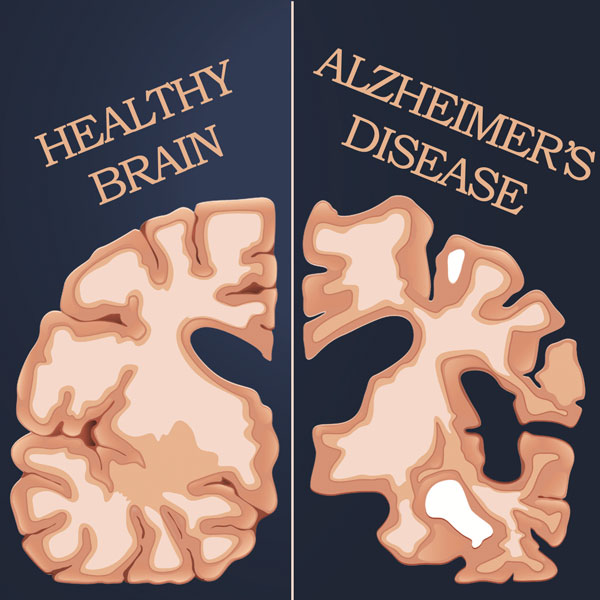In 1906, a German physician, Alois Alzheimer, presented a case history of a 51-year-old woman who had suffered from a rare brain disease. After she died, her brain autopsy revealed the shrinking of the brain and the plaques and tangles there that characterize the AD form of dementia. Today, this dreaded infirmary is growing at an alarming rate with number of deaths from AD having more than doubled between 2000 and 2017 (145%). Researchers are desperately searching for a cure. In this country alone, an estimated 5.8 million people are living with AD. Included in this figure are 5.6 million Americans over the age of 65 (Late Onset) and approximately 200,000 individuals under the age of 65 (Early Onset). Late Onset AD appears to be caused by the dying off of brain cells as seniors age. Early Onset, however, appears to be the result of tight familial genetic interference. 60-70% of all dementia cases lead to Alzheimer’s Disease.

The Alzheimer’s Association gives us these more clarifying statistics:
1. One in ten people age 65 and older or 10% has AD.
2. Almost two-thirds are women.
3. Older African-Americans are about twice as likely to have the disease (or other dementias) as older whites.
4. Hispanics are about one and one-half times as likely to have Alzheimer’s Disease or other dementias as older whites.
5. The disease is the 6th leading cause of death in the U.S.
6. While it is a leading cause of disability and poor health here, it is also the fifth-leading cause of death among those over the age of 65.
7. Among people age 70 with AD, 61 per cent are expected to die before the age of 80. This is a rate twice as high as those without AD (30%).
8. People age 65 and older generally can live an average of 4 to 8 years after a diagnosis. However, some may live as long as 20 years reflecting the uncertainty of the progression of the disease.
ALZinfo.org in their Winter 2019 magazine discusses the difference between dementia and Alzheimer’s disease.
Dementia is not a disease but rather a group of symptoms producing changes in behavior and thinking. It manifests itself with difficulty in performing everyday chores. Cooking, shopping, paying bills, driving a car, and daily hygiene can become problem areas. The medical publication explains that, “With dementia, the nerve cells in the brain stop working properly. The cells don’t talk to one another as they should. And as a result, the cells die.” A person with dementia has a greater number of these cells than normal that have become damaged. Over time, the progression of behavior and thinking difficulties become worse.
Dementia can be caused by a decrease in blood to the brain from a stroke, tumor, head injury or even a brain’s abnormal protein. However, the most prevalent form of dementia is Alzheimer’s Disease. Memory loss is the first and most common symptom of today’s widespread illness. While seniors often forget things, they usually remember these items later. With Alzheimer’s, patients don’t remember what they forgot. Often, people with AD ask the same line of questions repeatedly. They may cook a food item, but then forget to turn off the stove or forget to eat it. Alzheimer’s Disease definitely affects short-term memory and recently learned info. According to our informative guide, the below are other lifestyle problem areas:
1. Misunderstanding things around themselves
2. Difficulty in doing familiar tasks such as dressing oneself
3. Losing items or putting them in strange places. *This might include placing an article of clothing in a refrigerator
4. Poor judgment and decision making
5. Difficulty with problems using numbers or with several steps in direction finding; (6. Speaking with word retrieval difficulties
7. Getting lost after wondering away from a familiar area
8. A problem with reading or judging color
9. Exhibiting behavior, mood, and personality changes. *For no obvious reason, the Alzheimer’s patient may show suspicion, fear, anger, anxiousness, or crying.
While early stages of the illness do not show loss of contact with reality, symptoms do get worse. Eventually, your loved one will need more care and supervision. Today’s goal is to keep the patient independent for as long as possible. Certain medicines seem to slow down the symptoms, but not the disease’s progression. Like dementia, Alzheimer’s Disease does not have a current cure. Research continues at an intense pace. Much of it has been focused on stopping and possibly even reversing the destructive work of the beta-amyloid protein found on the brain cells. Another research is looking into the relationship between the immune system and the brain’s health and disease.
Next: Part 3: What can we do to help prevent Alzheimer’s from occurring?




